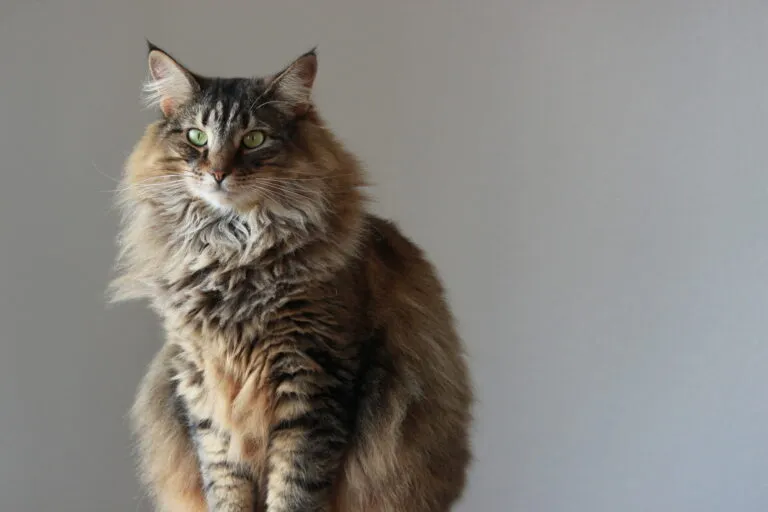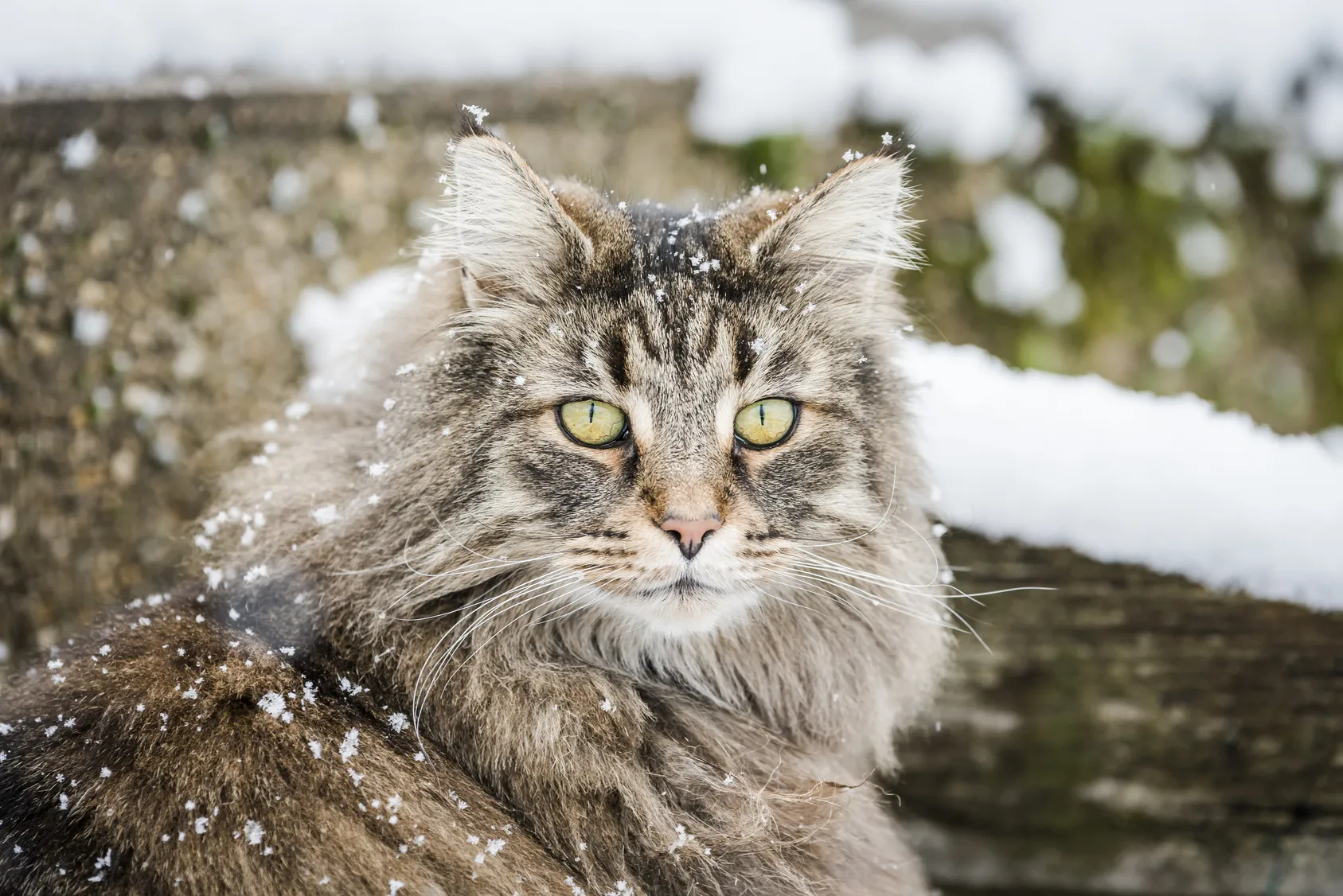Maine Coon
The Maine Coon has now become one of the most popular cat breeds in the world and is enjoying increasing popularity in Ireland, too. This is probably thanks to its authenticity, robustness and excellent character.
The Norwegian Forest cat emerged in its land of origin, Norway, free of human influence and wins hearts with its wild looks and genuine character. The Norwegian is original in more than just its appearance!

Like the Maine Coon and Ragdoll, the Norwegian Forest cat has semi-long fur. Its two-layer fur consists of water-repellent top hair with longer guard hairs and a thick undercoat. As with the Siberian cat, the Norwegian Forest cat changes its coat with the seasons: the winter coat with the thick underlayer is incredibly plushy and keeps the cat warm during the bitterly cold winter months in its homeland. As is the case with many long-haired cat breeds, there are even tufts of hair between the toes. The crown around the neck is prominently developed and very fluffy. In summer, the Norwegian Forest cat loses a significant amount of its undercoat, but maintains its bushy tail and “snowshoes”, or the tufts of hair between the paw pads.
By the way, the Norwegian’s fur texture differs greatly compared to the Maine Coon, even though the two breeds look similar at first glance. The Norwegian Forest cat’s water-repellent top hairs are often slightly oily and heavy, making the fur a little shaggy and less silky than the American wildcat’s coat. The Norwegians are quite simply perfectly adapted to temperatures below 30 degrees Celsius and heavy rain!
The Norwegians are not fully grown until reaching three to four years of age, since they are part of a breed of large cats. They then weigh up to 8kg. However, the breed is also more elongated and long-legged than many other breeds with semi-long fur. As a result, they often appear slightly slimmer than the Maine Coon, for instance. According to the breed standard, their face is triangular with high-set ears that are generously adorned with tufts of hair inside and on the tips. Their profile is straight and shows no stop.
All well-known domestic cat colours are allowed with Norwegian Forest cats, in combination with white too. Be they blotched, striped, spotted or ticked, black, blue, amber, tortoise shell, a mix of each different combination or white – a Norwegian Forest cat is always easy on the eye! Only cinnamon, fawn, the brownish chocolate colouration and its dilution lilac are excluded from the standard.
The Norwegians are known as “gentle giants” with good reason: fans of the breed are enraptured by their friendliness. Despite their size, they are incredibly peaceful and gentle. They might look like wild cats, but they devote themselves unconditionally to their people. These sociable animals also love sharing their territory with fellow cats and even small animals and dogs.
Due to their size and muscular strength, Norwegian cats are unusually skilled at climbing and jumping. They truly love playing and hunting and wish to be challenged accordingly. A secure garden or balcony with trees or full-length scratching trees are best suited, as here the Norwegian Forest cat can romp, climb and jump to its heart’s content! They are extremely curious and liked to be challenged mentally too.
Norwegian Forest cats’ playful instinct and robustness makes them great playmates for children. They are tolerant and friendly and very rarely nervous – provided that they are properly socialised during the rearing phase.
No matter how devoted the Norwegian is to its human family, this cat breed is extremely sociable and is therefore not suited to be kept as the only household cat. Ideally you should give two cats a home at the same time if you’ve found a responsible breeder! If you get your feline friend from an animal home, you can definitely receive explanations about the character of your future cat. They can also recommend cats that would make suitable companions!
Norwegian Forest cats are classed as one of the few “natural” cat breeds. They developed through natural selection based on their environment, without any assistance whatsoever or targeted selection by humans. Hence, Norwegian Forest cats are perfectly adapted to the harsh living conditions of their home country. Their thick, water-repellent fur is ideally suited for tough, snowy Scandinavian winters. As soon as they have lost their thick, plushy undercoat, they are ready for the hot, dry Northern European summer.
Known as “Norsk Skogatt” in their homeland, the rise of the Norwegian Forest cat began in similar fashion to that of the European Shorthair: hunting mice on Norwegian farms. Long-haired cats proved useful in granaries and stables. It is unknown how exactly wild domestic cats with long hair came about. It’s generally accepted that seafarers brought Persians with them as ship cats and crossed them incognito with local cats. However, the cause could also have been a stand-alone mutation in the Scandinavian cats’ gene pool.
Despite pairing with short-haired cats, the long-haired gene was passed down covertly to ensure that long-haired cats would keep showing up in litters belonging to short-haired parent cats. These cats formed the basis of the late Norwegian breed, which began in the 1930s. In 1938, the first Norwegian Forest cat was presented in Oslo. However, the outbreak of the Second World War initially brought systematic breeding to a standstill, and it took until the 70s for it to start up again. From 1972, the Norwegian Forest cat was recognised by Norwegian cat breeding associations and gained its own standard. In 1979, the first individual cats were registered with the Fédération Internationale Féline (Fifé). Only cats from the fourth generation and above were permitted for export, but nevertheless, the Norwegian Forest cat gained fans all over Europe!

As robust, primordial cats, Norwegian Forest cats don’t have any out-of-the-ordinary requirements for appropriate housing. Like all active cats, they benefit from access to a secured balcony or garden. A high scratching tree indoors ensures that these talented climbers can let off steam without damaging furniture or curtains.
Norwegians are social cats and should never be kept alone! They also bond well with children and often get on with other pets like dogs, but keeping another cat has clear advantages. After all, your Norwegian Forest cat needs a feline companion to play, romp around and cuddle with…
The Norwegian’s long coat is robust and can largely be taken care of by the cat itself. If you’d rather err on the side of caution and prevent the soft undercoat from felting, you’re well advised to groom your cat at least once a week. Generally it doesn’t cause a problem if the cat is used to grooming from an early age. During the moulting period, malt paste and cat grass can encourage natural withdrawal of swallowed hair.
Like all cats, Norwegian Forest cats should receive appropriate nutrition. A diet containing lots of fresh meat packed with healthy protein is ideal for these carnivorous animals. High-quality prepared food largely meets these requirements, but take a look at the packaging label: meat should be at the top of the list of ingredients. What’s more, cats shouldn’t just consume muscle meat, as offal such as the heart and liver also contain vital nutrients. However, don’t confuse these with the “animal by-products” that often feature – in most cases, this term refers to claws, cartilage and other waste products. Even plant by-products, sugar and other filler materials should ideally not feature.
An annual veterinary check-up is important in order to identify diseases at an early stage and also to take a look inside your cat’s mouth.
The Norwegian Forest cat developed through natural selection. As a result, it only rarely suffers from reproductive problems. Premature and stillbirths are extremely rare, for instance.
However, the Norwegian Forest cat shows a pre-disposal to hypertrophic cardiomyopathy (HCM). This heart disease is caused by an asymmetrical bulge in the left ventricle. Performing a heart ultrasound on animals to be bred is the best way to recognise hereditary heart disease at an early stage and to prevent affected cats from breeding. Hence, a responsible breeder regularly takes his cats to the vet and doesn’t hesitate to present the appropriate medical papers. Whilst there is no cure for HCM, a diagnosis does offer treatment possibilities that can still help affected cats live a long life!
The glycogen storage disease GSD4 also occurs frequently. It is recessively inherited and is often only recognised at a late stage. A kitten only inherits the GSD4 gene from one of its parents, whereby it then becomes a carrier and can pass on the disease to its descendants. They should therefore not take part in breeding. If the cat inherits the gene from both parents, it becomes severely ill: the lack of utilisation and consequent excessive storage of glycogen in the liver, muscles and nerve cells result in multiple organ failure. Affected cats show neuromuscular disorders from the age of around five months and have a maximum life expectancy of 10 to 14 months.
Hereditary diseases such as HCM and GSD4 demonstrate time and again the importance of regular check-ups, well thought-out pairings and excluding carriers of the said genes. The wellbeing of their animals and their offspring is of crucial importance to responsible breeders. They won’t shy away from any costs or effort involved in veterinary examinations for their animals and if necessary will exclude auspicious gene carriers from the breed.
When looking for your new family pet, please only trust responsible breeders and don’t let yourself be drawn in by small ads promising “low-cost pedigree cats”. If pedigree cats are on offer at a bargain price, this mainly comes at the animal’s expense. Maintaining a professional, responsible breed is an expensive hobby! Covering costs isn’t just part of the package for the breeder, as rearing costs for the kittens have to be taken into account too. They must offer the parents and their offspring a healthy diet and regularly take them to the vet for vaccinations and deworming. They don’t shy away from costs for preliminary examinations such as a cardiac ultrasound to diagnose HCM. They will give their kittens a loving home for 12 weeks, during which time they will be socialised and taught the necessities of life by their mother and siblings, until they are ready to move in with their new human family. On top of this are cat association membership fees, castration costs and potentially other additional expenses.
Of course, this all comes at a cost. A collector’s cat that won’t be used for breeding costs between 700 and 1,000 euros. With this, the breeder just about covers his costs and certainly doesn’t receive a big windfall…
Of course, not all cat lovers can afford to pay such fees. Local animal homes offer an alternative. Pedigree cats often end up in animal homes – maybe you’ll find the Norwegian Forest cat of your dreams? But remember one thing: Norwegian Forest cats are social animals and should never be kept alone!
The Maine Coon has now become one of the most popular cat breeds in the world and is enjoying increasing popularity in Ireland, too. This is probably thanks to its authenticity, robustness and excellent character.
Neva Masquerade – a mysterious name for a mysterious thing of beauty! The Neva Masquerade is the point variation on the Siberian cat and shares many characteristics with this breed.